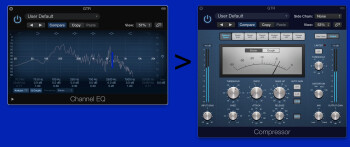Before we tackle the next major section of this series ─ dynamics ─ let's diverge briefly to take stock of where we are in the process, and cover an important issue involving effect-chain order.
In the loop
First of all, a brief reminder that I think is necessary. As I was telling you in a previous article, you are caught in a loop where every pass implies a small readjustment of the previous ones. In other words, after you’ve finished EQing your song, it would be wise to take another quick look at the previous panning and volume stages. In fact, the work you did with the EQ ought to make all elements in your sonic puzzle bond together better. As a consequence, chances are the balance you had found during the rough mix might not be fully optimal now. But be careful, I’m not talking about any major changes here, some slight retouches here and there ought to be more than enough. If you compare the version at the current stage with the previous ones, you should be able to notice a substantial gain in terms of clarity and definition. It’s not really necessary to make a new bounce as a reference for future stages right now; however, it wouldn’t take you long and it could be interesting to follow the evolution of your mix gradually.
Chicken or the egg…
In the next stage, we’ll deal with dynamics. But if you say dynamics, you say compression. And that’s why it’s important to ask yourself the order of the processing chain. What comes first, the EQ or the compressor? There’s no clear-cut answer to this famous dilemma. Certain budding audio engineers say compression must be first, while some others swear that the other way around is much better. On the other hand, seasoned engineers know there’s no blanket rule in this respect and that the only rule that applies is the one that works in the particular case you’re working on. That’s why it’s important to understand the pros and cons of every approach before making a decision.
EQing before compressing might be counterproductive. Indeed, if you amplify a certain zone of the spectrum, odds are these frequencies will trigger the compressor more easily. In fact, they risk being “crushed” by the latter and, thus, not being able to stand out, which is the exact opposite of you what you intended. And boosting the EQ even more will definitely not solve the problem, because the compressor will always work in the opposite direction.
Given this, you might think that you just need to place the EQ after the compressor to avoid this phenomenon. Except that, this gives way to yet another problem. If you consider the basics, compression is meant to reduce the dynamics of a signal by minimizing the difference between the highest and lowest levels. Hence, all undesired frequencies present in the signal will be reinforced and you will need to apply even more drastic EQing to get rid of them, which will be detrimental for the naturalness of the track.
The ultimate solution could be to place an EQ before the compressor, to clean up the signal, and another one after the compression, to amplify the adequate frequencies. Yes, but that would mean going against the idea of “less is more, ” besides putting a strain on the natural quality of sound itself. What a dilemma! In practice, though, things are not that complicated. First of all, as you will see later on, not all tracks need drastic compression and, in fact, many of them don’t need any at all. In this case, there’s no real issue because the influence of any eventual “soft” compression on the EQ will be almost inaudible.
On the other hand, after reading the previous episodes, you should already know that it’s not very useful to boost frequencies with an EQ. From the moment a track sounds the way you want it to, a simple cleanup of the frequency spectrum might be enough. Once again, you shouldn’t have an issue with this since an EQ before the compressor ought to do the job perfectly.
As for the use of one EQ before and one after the compressor, don’t let the “less is more” approach turn into an obsession! As Sherlock Holmes used to say: “When you have eliminated the impossible, whatever remains, however improbable, must be the truth.” If you think the best way to go is to use two EQs, so be it! But you shouldn’t make a habit out of that, obviously.
Finally, make the best use of your DAWs flexibility to handle track inserts. Back in the analog days, placing an EQ before the compressor required a specific patching and switching the other way around was no easy task. Today, you can change the order of the processing chain with a simple drag and drop, so try it out! It won’t cost you a penny and you can choose the best solution on a case-by-case basis.
More on this next week, with the first installment dedicated to dynamics processing.


